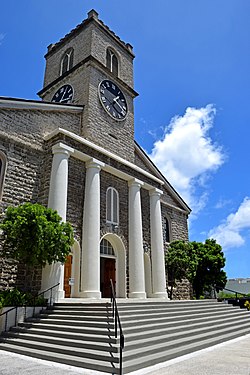|
Kawaiahaʻo Church
Kawaiahaʻo Church is a historic Congregational church located in Downtown Honolulu on the Hawaiian Island of Oʻahu. The church, along with the Mission Houses, comprise the Hawaiian Mission Houses Historic Site, which was designated a U.S. National Historic Landmark (NHL) in 1962.[1][3] In 1966 it and all other NHLs were included in the first issuance of the National Register of Historic Places. At one time the central church of the Kingdom of Hawaiʻi and chapel of the Hawaiʻian royal family, the church is popularly known as “Hawaiʻi's Westminster Abbey”. The name comes from the Hawaiian noun phrase ka wai a Haʻo (“the water of Haʻo”), because its location had a spring and freshwater pool of a High Chiefess named Haʻo.[4] It has also been called hale pule lahui (“Great Stone Church”), the Hawaiian Tabernacle (luakini), the Mother Church, the Kingʻs Church, the Kingʻs Chapel, and the "Aliʻi Church". Today, Kawaiahaʻo continues to use the Hawaiian language for parts of its services. It is the oldest church on Oʻahu and one of the oldest standing Christian places of worship in Hawaiʻi, although four thatched churches stood at or near the site of the present coral church. The oldest standing church is Mokuaikaua Church on the Island of Hawaiʻi. Denominationally, it is part of the United Church of Christ. History  The Kawaiaha'o mission was started in 1820. The stone building of Kawaiahaʻo Church was commissioned by the regency of Kaʻahumanu, during the reigns of Kamehameha II and Kamehameha III. Designed by Rev. Hiram Bingham in the New England style of the Hawaiian missionaries, it was constructed between 1836 and 1842 of some 14,000 thousand-pound slabs of coral rock quarried from an offshore reef on the southern coast of Oʻahu. Hawaiian divers dove three to six metres below sea-level to chisel out each coral block with hand tools, and the blocks then were transported from the reef onto the shore.[5] The church house rivaled the concurrent construction of the Cathedral of Our Lady of Peace by the Roman Catholic Apostolic Vicariate of the Hawaiian Islands. Construction began on that churchhouse in 1840 and was substantially completed in 1843, one year after the completion of Kawaiahaʻo Church. The name Kawaiahaʻo was not applied to the site until 1853. Kawaiahaʻo Church was frequented by the chiefs of the Hawaiian Islands as well as the members of the reigning Kamehameha dynasty and Kalākaua dynasty. Kamehameha III, Kamehameha IV, Kamehameha V and Kalakaua took their oaths of office to their constitutions at Kawaiahaʻo Church. State burials were also held at the church as well the baptisms of aliʻi including aliʻi members who would eventually convert to other denominations or faiths. Today, the upper gallery of the sanctuary is adorned with 20 portraits of Hawaiian royalty (Aliʻi).[6] The body of King Lunalilo, who preferred burial in a church cemetery to burial in the Royal Mausoleum, is buried in a crypt along with his father near the front courtyard. But Kawaiahaʻo Church was not the only site of royal worship in the Islands. Kamehameha IV and his wife Emma were devout members of the Church of England and established the Anglican Church of Hawaiʻi, which evolved into the present-day Episcopal Diocese of Hawaiʻi after the islands were annexed by the United States and later gained statehood. The royal couple commissioned the construction of the Cathedral Church of Saint Andrew, which replaced Kawaiahaʻo Church as the principal centre of royal worship. Kamehameha V, Kalākaua, and Liliʻuokalani (after the rebellion which overthrew the kingdom) preferred to use the cathedral – even though, before her reign, then Princess Liliʻuokalani had directed the choir of Kawaiahaʻo Church. When Liliʻuokalani died in 1917, she lay in state in the church for a week before her funeral at Iolani Palace.[7] People associated with the church
Other well-known persons associated with the church include:
List of Nā Kahu (senior pastors)
List of interim pastors
See alsoReferences
External linksWikimedia Commons has media related to Kawaiahaʻo Church.
Information related to Kawaiahaʻo Church |
||||||||||||||||||||||||||||||||||||||||||||||||||||||||||||||||||||



